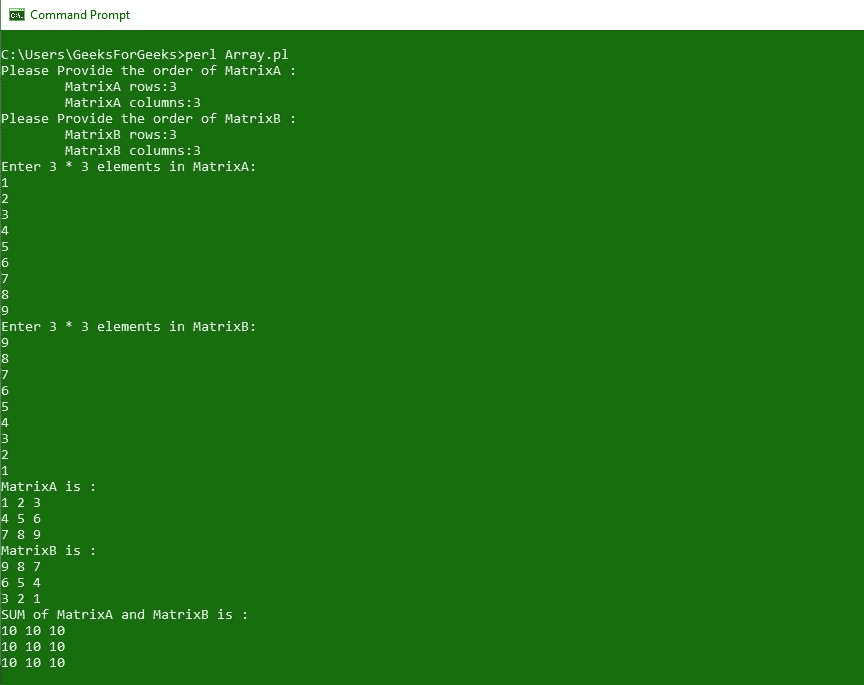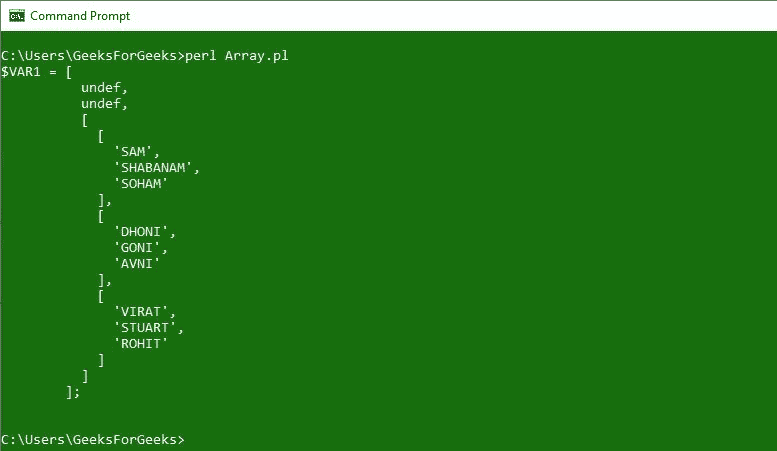Perl |多维数组
原文:https://www.geeksforgeeks.org/perl-multidimensional-arrays/
Perl 中的多维数组是具有多个维度的数组。从技术上讲,在 Perl 中没有多维数组这种东西,但是数组是用来充当多维数组的。多维数组以行和列的形式表示,也称为矩阵。一个数组的每个元素都可以是另一个数组的引用,但是在语法上,它们看起来像一个二维数组。
多维数组只能保存标量值,不能保存数组或哈希值。
多维数组的初始化和声明
下面给出的例子说明了多维数组的初始化和声明。 在本例中,我们将简单地通过@ array _ name =([……],[……],[……])初始化数组;。
Perl 语言
#!/usr/bin/perl
use strict;
use warnings;
# Initializing and defining the array
my @items = ( ['book', 'pen', 'pencil'],
['Bat', 'Ball', 'Stumps'],
['snake', 'rat', 'rabbit'] );
# Printing items from the array
print $items[0][0], "\n";
print $items[1][1], "\n";
print $items[2][2], "\n";
输出:

创建矩阵
矩阵是多个维度上的数组的行和列的集合。 我们来看一个例子,让大家更清楚在 Perl 中创建矩阵。
示例 1: 在本例中,我们首先声明了三个带值的数组,然后将它们合并成最终的结果数组,形成一个 3*3 矩阵。为了控制变量 \(m 和\)n ,使用了两个 for 循环。
Perl 语言
#!/usr/bin/perl
use strict;
use warnings;
# Array Declaration
my @arrayA = qw(1 0 0);
my @arrayB = qw(0 1 0);
my @arrayC = qw(0 0 1);
# Merging 3 arrays into One Final array
my @result = (\@arrayA, \@arrayB, \@arrayC);
print "Resultant 3*3 Matrix:\n";
# Using For loop
for(my $m = 0; $m <= $#result; $m++)
{
for(my $n = 0; $n <= $#result ; $n++)
{
print "$result[$m][$n] ";
}
print "\n";
}
输出:

示例 2: 在本例中,我们将从键盘获取输入,然后将两个矩阵相加,并使用结果矩阵打印结果。
Perl 语言
#!usr/bin/perl
use strict;
use warnings;
my (@MatrixA, @MatrixB, @Resultant) = ((), (), ());
# Asking for User Input for Matrix A
print "Please Provide the order of MatrixA :\n";
print "\tMatrixA rows:";
chomp(my $rowA = <>); # CHOMP TO TAKE USER INPUT
print "\tMatrixA columns:";
chomp(my $columnA = <>);
# Asking for User Input for Matrix B
print "Please Provide the order of MatrixB :\n";
print "\tMatrixB rows:";
chomp(my $rowB = <>);
print "\tMatrixB columns:";
chomp(my $columnB = <>);
# Asking User to input elements of matrices
if ($rowA == $rowB and $columnA == $columnB)
{
print "Enter $rowA * $columnA elements in MatrixA:\n";
foreach my $m (0..$rowA - 1)
{
foreach my $n (0..$columnA - 1)
{
chomp($MatrixA[$m][$n] = <>); # TO READ THE VALUES
}
}
print "Enter $rowB * $columnB elements in MatrixB:\n";
foreach my $m (0..$rowB - 1)
{
foreach my $n (0..$columnB - 1)
{
chomp($MatrixB[$m][$n] = <>); # TO READ THE VALUES
}
}
# Performing Addition operation
foreach my $m (0..$rowB - 1)
{
foreach my $n (0..$columnB - 1)
{
$Resultant[$m][$n] = $MatrixA[$m][$n] +
$MatrixB[$m][$n];
}
}
# Printing Matrix A
print "MatrixA is :\n";
foreach my $m (0..$rowB - 1)
{
foreach my $n (0..$columnB - 1)
{
print "$MatrixA[$m][$n] ";
}
print "\n";
}
# Printing Matrix B
print "MatrixB is :\n";
foreach my $m (0..$rowB - 1)
{
foreach my $n (0..$columnB - 1)
{
print "$MatrixB[$m][$n] ";
}
print "\n";
}
# Printing the sum of Matrices
print "SUM of MatrixA and MatrixB is :\n";
foreach my $m (0..$rowB - 1)
{
foreach my $n (0..$columnB - 1)
{
print "$Resultant[$m][$n] ";
}
print "\n";
}
}
# Error if Matrices are of different order
else
{
print "Matrices order does not MATCH, Addition is not Possible";
}
输出:

只有当矩阵具有相同的顺序时,才能执行矩阵相加。

数组的数组
数组数组是具有数组的数据结构,该数组具有数组引用列表。数组中的元素是数组引用。根据需要,可以单独打印这些参考,也可以打印整个阵列。
语法:
@ARRAY_NAME = ([value1], [value2], [value3], ..., [valueN]);
例 1:
Perl 语言
#!/usr/bin/perl
use strict;
use warnings;
# Array of Arrays
my @GfG = ( ["Geek", "For", "Geeks"],
["Is", "Best", "For"],
["Those", "In", "Need"] );
# Printing internal array elements
print "Accessing Array elements:\n";
print @{$GfG[0]}[1], "\n"; # For accessing particular array element
print @{$GfG[1]}[0], "\n";
print @{$GfG[2]}[2], "\n";
# Printing whole Arrays
print "\nAccessing whole arrays: \n";
print @{$GfG[0]}, "\n"; # For accessing particular array
print @{$GfG[1]}, "\n";
print @{$GfG[2]}, "\n";
print "\n";
输出:

例 2:
在这个例子中,我们通过使用单个数组生成了一个数组数组。
Perl 语言
#!/usr/bin/perl
use strict;
use warnings;
use Data::Dumper;
my @GfG = ( ["SAM", "SHABANAM", "SOHAM"],
["DHONI", "GONI", "AVNI"],
["VIRAT", "STUART", "ROHIT"] );
my @test;
foreach (@GfG)
{
if ($_ =~ /M/ )
{
push ( @{$test[0]}, $_);
}
elsif ($_ =~ /I/ )
{
push ( @{$test[1]}, $_);
}
else
{
push ( @{$test[2]}, $_);
}
}
print Dumper(\@test), "\n";
输出:

哈希数组
散列数组是一种数据结构,其中数组有一个散列列表。散列引用是数组的对象。为了访问键和值,我们需要取消对它们的引用。 如果我们想在数字上循环散列,散列数组是一个很好的数据结构。
语法:
@ARRAY_NAME = ({KEY1 => VALUE1}, {KEY2 => VALUE2});
例 1:
Perl 语言
#!/usr/bin/perl
use strict;
use warnings;
my @hashtest = ({ First => "Geek",
Middle => "For",
Last => "Geeks" },
{ Street => "Royal Kapsons",
City => "Noida-Uttar Pradesh" },
{ About => "Computer Science portal",
Content => "Technical" });
# To access any of the hash reference.
print $hashtest[0], "\n";
# To access keys of any hash reference.
print keys %{$hashtest[2]}, "\n";
# To access any value of any key.
print $hashtest[0]->{"First"}, "\n";
print $hashtest[0]->{"Middle"}, "\n";
print $hashtest[0]->{"Last"}, "\n";
输出:

示例 2: 从一个简单的数组生成一个哈希数组。
Perl 语言
#!/usr/bin/perl
use strict;
use warnings;
use Data::Dumper;
my @array = ("Item - Java Course",
"Cost - 5000",
"Ratings - 5 star");
# Empty array of hashes
my @array_1;
foreach (@array)
{
my @array = split(" - ", $_);
$array_1[0]->{$array[0]} = $array[1];
}
print Dumper (\@array_1);
输出:

